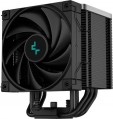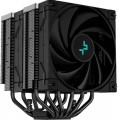Double-tower
A feature found in some active CPU coolers (see "Intended Use").
For tower arrangements in general, see Airflow Blowing below. And
the double-tower design means that the cooler has two working blocks — that is, two fans and two radiators. Accordingly, there are more heat pipes in the design than in single-tower models — at least 4 of them, and more often 5 – 6 or even more. Such an arrangement can significantly increase the cooling efficiency; on the other hand, it also significantly affects the dimensions, weight and price.
Max. TDP
The maximum TDP provided by the cooling system. Note that this parameter is indicated only for solutions equipped with heatsinks (see "Type"); for separately made fans, the efficiency is determined by other parameters, primarily by the air flow values (see above).
TDP can be described as the amount of heat that a cooling system is able to remove from a serviced component. Accordingly, for the normal operation of the entire system, it is necessary that the TDP of the cooling system is not lower than the heat dissipation of this component (heat dissipation data is usually indicated in the detailed characteristics of the components). And it is best to select coolers with a power margin of at least 20 – 25% — this will give an additional guarantee in case of forced operation modes and emergency situations (including clogging of the case and reduced air exchange efficiency).
As for specific numbers, the most modest modern cooling systems provide TDP
up to 100 W, the most advanced —
up to 250 W and even
higher.
Number of fans
The number of fans in the design of the cooling system. More fans provide higher efficiency (all else being equal); on the other hand, the dimensions and the noise generated during operation also increase accordingly. Also, note that other things being equal, a smaller number of large fans is considered more advanced than numerous small ones; see "Fan diameter" for details.
Noise level
The standard noise level generated by the cooling system during operation. Usually, this paragraph indicates the maximum noise during normal operation, without overloads and other "extreme".
Note that the noise level is indicated in decibels, and this is a non-linear value. So it is easiest to evaluate the actual loudness using comparative tables. Here is a table for values found in modern cooling systems:
20 dB — barely audible sound (quiet whisper of a person at a distance of about 1 m, sound background in an open field outside the city in calm weather);
25 dB — very quiet (normal whisper at a distance of 1 m);
30 dB — quiet (wall clock). It is this noise that, according to sanitary standards, is the maximum allowable for constant sound sources at night (from 23.00 to 07.00). This means that if the computer is planned to sit at night, it is desirable that the volume of the cooling system does not exceed this value.
35 dB — conversation in an undertone, sound background in a quiet library;
40 dB — conversation, relatively quiet, but already in full voice. The maximum permissible noise level for residential premises in the daytime, from 7.00 to 23.00, according to sanitary standards. However, even the noisiest cooling systems usually do not reach this indicator, the maximum for such equipment is about 38 – 39 dB.
Heat pipes
Number of heat pipes in the cooling system
The heat pipe is a hermetically sealed structure containing a low-boiling liquid. When one end of the tube is heated, this liquid evaporates and condenses at the other end, thus removing heat from the heating source and transferring it to the cooler. Nowadays, such devices are widely used mainly in processor cooling systems (see "Intended use") — they connect the substrate that is in direct contact with the CPU and the heatsink of the active cooler. Manufacturers select the number of tubes based on the overall performance of the cooler (see "Maximum TDP"); however, models with similar TDPs can still differ markedly in this parameter. In such cases, it is worth considering the following: increasing the number of heat pipes increases the efficiency of heat transfer, but also increases the dimensions, weight and cost of the entire structure.
As for the number, the simplest models provide
1 – 2 heat pipes, and in the most advanced and powerful processor systems, this number can be
7 or more.
Plate material
The material from which the substrate of the cooling system is made is the surface that is in direct contact with the cooled component (most often the processor). This parameter is especially important for models with heat pipes (see above), although it can be specified for coolers without this function. Options can be as follows:
aluminium,
nickel-plated aluminium,
copper,
nickel-plated stranded. More about them.
— Aluminium. The traditional, most common backing material. At a relatively low cost, aluminium has good thermal conductivity characteristics, is easy to grind (required for a snug fit), and well resists scratches and other irregularities, as well as corrosion. However in terms of heat removal efficiency, this material is still inferior to copper — however, this becomes noticeable mainly in advanced systems that require the highest possible thermal conductivity.
— Copper. Copper is noticeably more expensive than aluminium, but this is offset by higher thermal conductivity and, accordingly, cooling efficiency. The noticeable disadvantages of this metal include some tendency to corrosion when exposed to moisture and certain substances. Therefore, pure copper is used relatively rarely — nickel-plated substrates are more common (see below).
— Nickel-plated copper. Copper substrate with an additional n
...ickel coating. Such a coating increases resistance to corrosion and scratches, while it practically does not affect the thermal conductivity of the substrate and work efficiency. However this feature somewhat increases the price of the radiator, but it is found mainly in high-end cooling systems, where this moment is almost invisible against the background of the overall cost of the device.
— Nickel-plated aluminium. Aluminium substrate with an additional nickel coating. For aluminium in general, see above, and the coating makes the heatsink more resistant to corrosion, scratches, and burrs. On the other hand, it affects the cost, despite the fact that in fact, pure aluminium is often quite sufficient for efficient operation (especially since this metal itself is very resistant to corrosion). Therefore, this variant was not distributed.RAM space
The height of the space for RAM (random access memory) provided by the design of the cooling system.
Such a space is found predominantly in processor systems (see "Purpose"). Modern CPU coolers can be very large, and when installed, they often cover the RAM slots closest to the processor. This can be avoided by making the design narrow enough — however, this, in turn, negatively affects efficiency. That's why many manufacturers use another option — they don't limit the width of the cooler, but place its components at a high height, allowing you to place RAM bars of a certain height under them. Sometimes a special cutout is even made at the bottom of the radiator, which further increases the available space. And in this paragraph, the maximum height of the bar that can be placed under the cooling system is indicated.
Dimensions
General dimensions of the cooling system. For water systems (see "Type"), this paragraph indicates the size of the external radiator (the dimensions of the water block in such devices are small, and there is no need to specify them in particular).
In general, this is a fairly obvious parameter. We only note that for case fans (see ibid.), the thickness is of particular importance — it directly depends on how much space the device will take up inside the system unit. At the same time, it is customary to refer to
fans with a thin case for models in which this size does not exceed 20 mm.
Height
The cooling system should fit into the computer case without any problems. The vast majority of case manufacturers indicate in the specifications the maximum height of the cooler that can be installed on their chassis. It is from this value that it is necessary to build on when choosing a cooling system. With an oversized cooler, you will have to leave the side wall of the case wide open, which violates the built-in air circulation pattern and provokes dust pollution of the internal space of the system unit.

